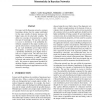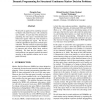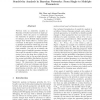UAI
2004
15 years 2 months ago
2004
For many real-life Bayesian networks, common knowledge dictates that the output established for the main variable of interest increases with higher values for the observable varia...
UAI
2004
15 years 2 months ago
2004
We present a major improvement to the incremental pruning algorithm for solving partially observable Markov decision processes. Our technique targets the cross-sum step of the dyn...
95
Voted
UAI
2004
15 years 2 months ago
2004
We describe an approach for exploiting structure in Markov Decision Processes with continuous state variables. At each step of the dynamic programming, the state space is dynamica...
86
Voted
UAI
2004
15 years 2 months ago
2004
Ancestral graph models, introduced by Richardson and Spirtes (2002), generalize both Markov random fields and Bayesian networks to a class of graphs with a global Markov property ...
97
Voted
UAI
2004
15 years 2 months ago
2004
The paper introduces mixed networks, a new framework for expressing and reasoning with probabilistic and deterministic information. The framework combines belief networks with con...
105
click to vote
UAI
2004
15 years 2 months ago
2004
Early, reliable detection of disease outbreaks is a critical problem today. This paper reports an investigation of the use of causal Bayesian networks to model spatio-temporal pat...
108
Voted
UAI
2004
15 years 2 months ago
2004
Mixtures of truncated exponentials (MTE) potentials are an alternative to discretization for representing continuous chance variables in influence diagrams. Also, MTE potentials c...
103
Voted
UAI
2004
15 years 2 months ago
2004
Defeasible argumentation frameworks have evolved to become a sound setting to formalize commonsense, qualitative reasoning from incomplete and potentially inconsistent knowledge. ...
121
Voted
UAI
2004
15 years 2 months ago
2004
Previous work on sensitivity analysis in Bayesian networks has focused on single parameters, where the goal is to understand the sensitivity of queries to single parameter changes...
UAI
2004
15 years 2 months ago
2004





